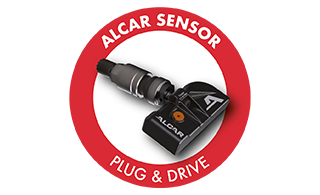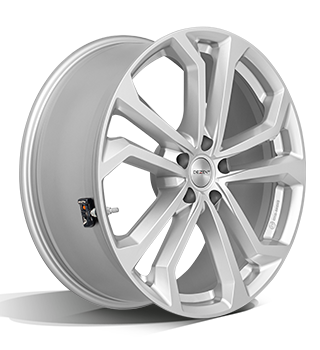alcar tyre pressure monitoring systems
advantage through know-how - wheels by alcar are 100% tpms-fit
Fact is that since 1st November 2014, the new EU Tyre Pressure Monitoring System Directive will apply to all newly registered cars. All ALCAR wheels have already been prepared to accommodate the necessary wireless sensors (direct TPMS) and the relevant information have been recorded in TÜV certificates since the beginning of 2012.
Read here about what the four letters TPMS stand for in detail and which kind of comprehensive support you can expect as an ALCAR busines partner.
tpms basics
WHAT IS TPMS?Tyre Pressure Monitoring Systems (TPMS) are vehicle-integrated systems which continuously monitor the tyre pressure. There are two different system types; the direct system (measuring the tyre pressure via a sensor in the wheel) and the indirect system (measuring via the vehicle’s ABS sensor). A display inside the vehicle informs the driver if one or more tyres lose pressure.
TPMS fulfil four functions:
Increased driving safety due to better gripping power, sturdier steering behaviour and shorter braking distance
Avoiding higher fuel consumption caused by wrong tyre pressure
Avoiding high tyre wear which is caused by reduced tyre pressure
Reducing CO2 emissions due to lower fuel consumption and longer life span of tyres

TPMS LEGAL REQUIREMENTS
WHICH LEGAL REQUIREMENTS MUST TPMS FULFIL?In general, the following applies since 1st November 2014: according to the EU Directive, all new cars must be equipped with a TPMS by the vehicle manufacturers.
However, the EU Directive does not stipulate which tyre pressure monitoring system should be used. Permitted are direct as well as indirect systems as long as they fulfil the requirements and conditions of ECE-R 64. ECE-R64 only stipulates the functionality but not whether an original or aftermarket sensor is required.
Important: A TPMS found not to be in proper working order during the annual TUEV is classed as a minor defect and must be rectified by the vehicle owner immediately.

tpms & purchasing wheels
What should I look for when purchasing wheels?If your vehicle is already equipped with a TPMS then you need to establish whether it is a direct or indirect system. In case that your vehicle is equipped with an indirect TPMS then you can purchase your wheels as per usual as this will not affect your TPMS.
If your TPMS is a direct system then you should look for the following when purchasing wheels:
1. Does the wheel design of your choice fulfil all requirements for fitting a TPMS sensor?
2. Due to the complex technology of the TPMS, we recommend to use a specialist dealer. They have the relevant special tools and programming equipment for changing tyres, maintenance work and for any other problems (e.g. warning on the display)!
All ALCAR wheels have already been prepared to accommodate the necessary wireless sensors (direct TPMS) and the relevant information have been recorded in TÜV certificates since the beginning of 2012.
Therefore, the purchase of wheels is easy because nothing changes for ALCAR customers.

TPMS EXPERT KNOW-HOW
Technical details and effects of TPMS on maintenance and serviceWhat are the differences between a direct and an indirect system?
A direct system measures the tyre pressure via a sensor integrated in the wheel. This information is wirelessly transferred to a control device in the vehicle. Various displays of individual vehicle manufacturers enable the driver to read the current pressure values permanently or to receive just a warning when the tyre pressure is too low. Such systems are very precise since they directly monitor the pressure for each wheel.
How does an indirect TPMS work?
In an indirect system, the vehicle integrated ABS and traction sensors monitor individual wheel rotational speeds. Differences would occur if a pressure drop in the tires appears. In addition, pressure-dependent oscillations of the wheels are measured through advanced signal processing. A change will be considered a further indication of a loss of pressure.
What are the advantages and disadvantages of these systems?
A direct TPMS allows for a very precise data collection and has additional functions like tyre position recognition, pressure loss detection when the vehicle is stationary and monitoring the tyre pressure of the spare wheel. A direct TPMS requires a significant extra effort and expenditure when changing tyres and during maintenance work. All tyres (summer, winter, spare) of a vehicle must be equipped with a properly working sensor.
An indirect TPMS is not as precise in its functionality since it neither measures the tyre pressure nor the tyre temperature. Also, it does not detect loss of pressure on the tyres when the vehicle is stationary. However, the system is far easier to maintain and less costly since wheel sensors are not used.
What effects have TPM systems on maintenance and service?
The use of TPMS when driving and maintaining a vehicle poses new challenges for the driver and workshops alike: The vehicle owner will not be able to simply change a tyre by himself but will need the help of a specially qualified dealer in order to fit, calibrate and check the sensor of wheels with a direct TPMS. Due to the EU-wide introduction of this technology, specialist dealers will train their staff and invest in the required equipment.
Can I fit tyres with direct TPMS myself?
Tyre mounting is a safety-relevant issue and requires expertise (check of a condition of the tire, use the correct tightening torque, ...). Therefore, we recommend this principle to only be carried out by a specialist dealer.
Direct TPMS systems also bring the following new technical requirements:
- The need for maintenance of the valve and the gaskets with every wheel removal to prevent wear of the sensor
- For new tyres: new configuration of the sensors to the vehicle when new sensors (new sensor ID) are used or amending the wheel position of the sensors in order to ensure the clear communication between sensor and TPMS receiver
- The battery level of the sensors must be checked when changing tyres
My vehicle is not equipped with a TPMS. Do I now need to get a TPMS fitted?
Vehicles which are subject to the compulsory fitting of a TPMS will already be equipped with a direct or indirect TPMS by the vehicle manufacturer as otherwise the vehicle will not be given a type approval and/or certification in any of the EU member states.
A subsequent installation of a TPMS is not mandatory.
TPMS COMPETENCE AS A KEY TO SUCCESS
alcar TPMS TRAINING VIDEO NOW online
As one of the leading European providers of steel and alloy wheels in the passenger car aftermarket we not only put emphasis on the highest quality with our products but also onour service.
As a provider of a complete industry TPMS solution ALCAR now offers workshops a new training video for free. Tyre, wheel and sensor have to fit each other perfectly and thisrequires competent advice and programming. This can be provided only by best practise dealers in the future.
Tyre dealers should thus not deem the EU Regulation an extra burden, but an opportunity to regain lost market shares. Only with the right tools and know-how a TPMS will work in everyday life.
See for yourself how easily and just in a few steps it is to become a tire-pressure-monitoring-system-specialist.
TPMS – four letters – one solution: ALCAR!
Before you make a decision, talk to ALCAR!